Unit 3 Could you please tell me where the restrooms are? Section A (1a—2d) 课件(共22张PPT,无音频)
文档属性
| 名称 | Unit 3 Could you please tell me where the restrooms are? Section A (1a—2d) 课件(共22张PPT,无音频) |  | |
| 格式 | pptx | ||
| 文件大小 | 3.0MB | ||
| 资源类型 | 教案 | ||
| 版本资源 | 人教新目标(Go for it)版 | ||
| 科目 | 英语 | ||
| 更新时间 | 2025-02-08 09:48:25 | ||
图片预览

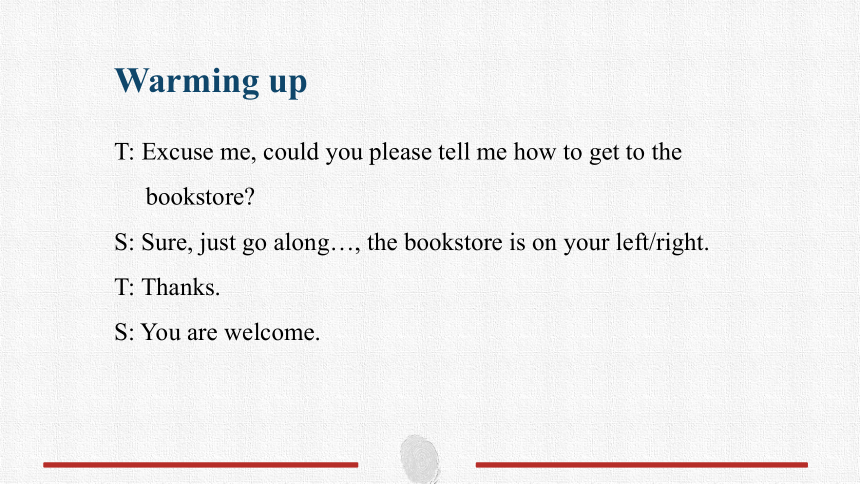
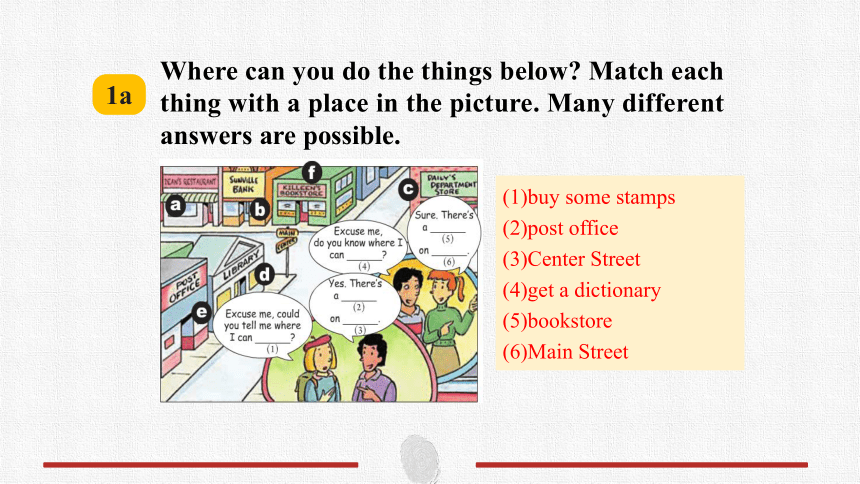
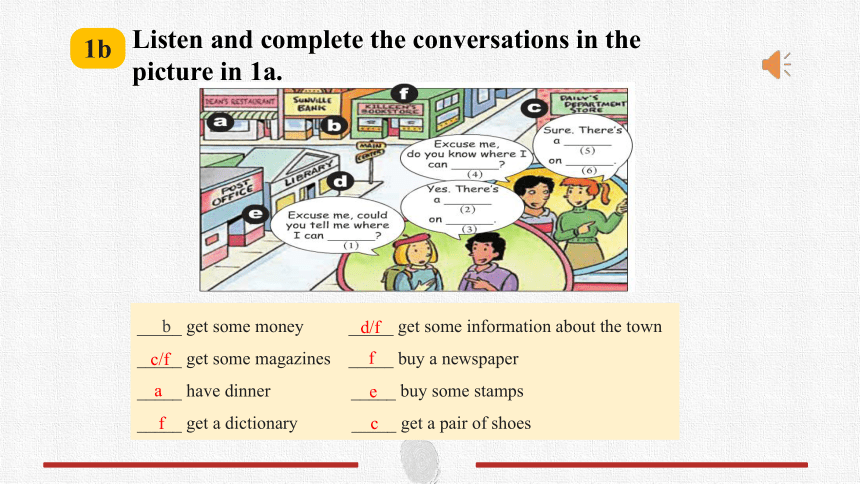
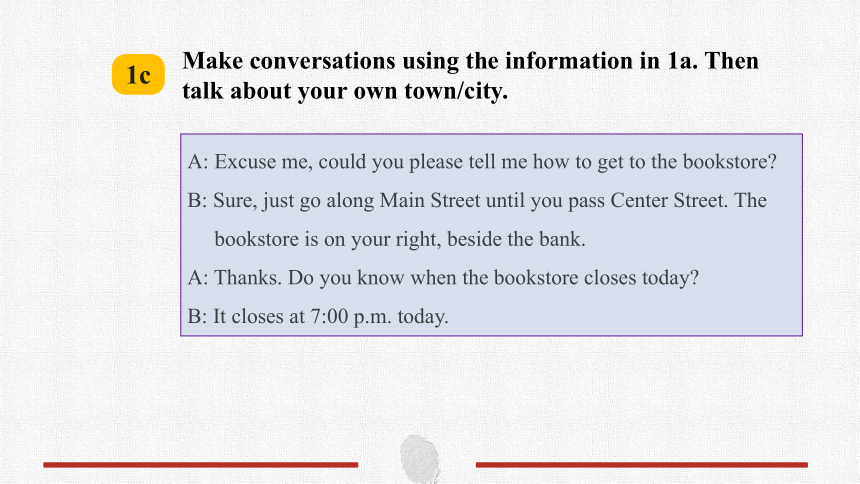
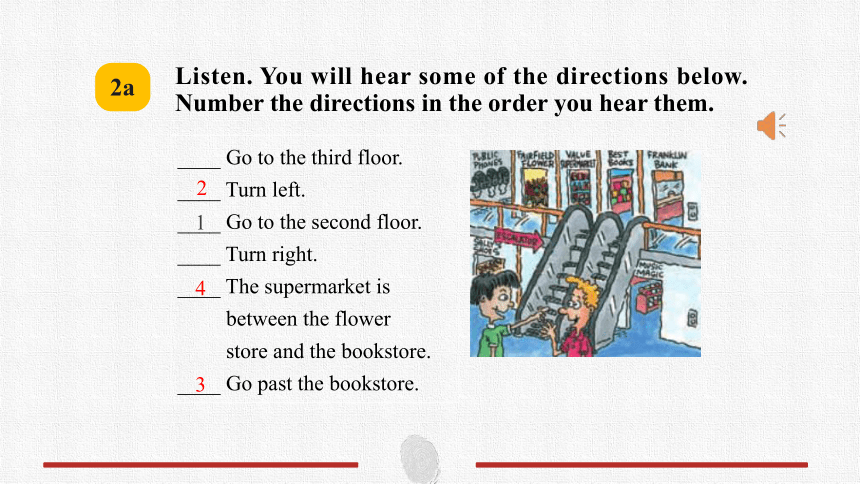
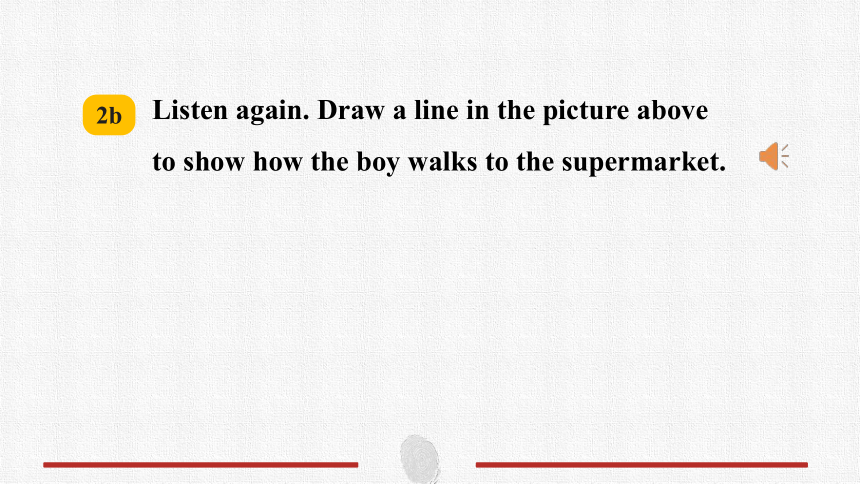
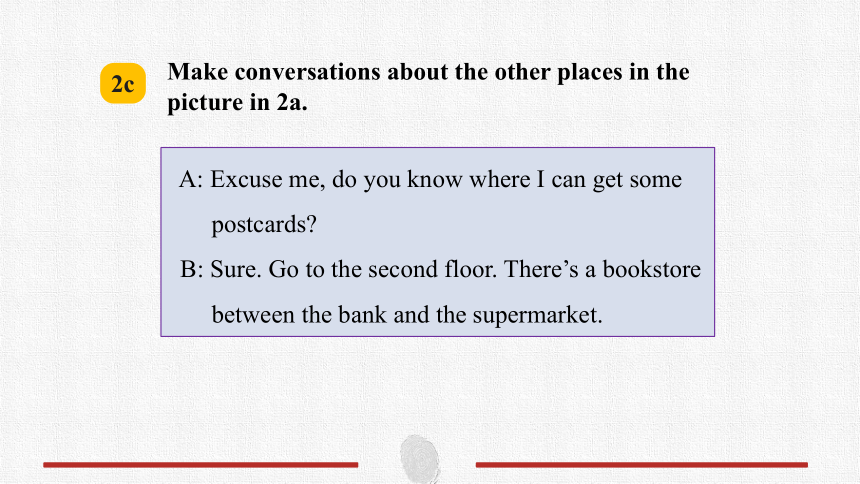
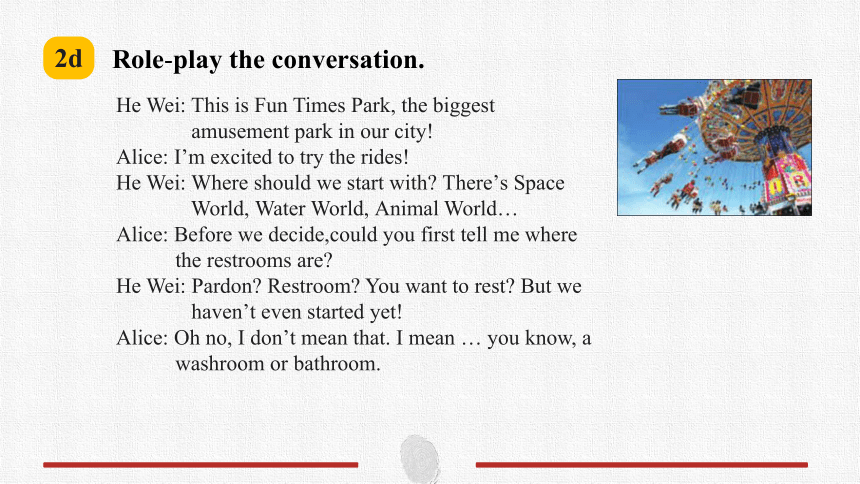
文档简介
(共22张PPT)
Unit 3 Could you please tell me
where the restrooms are
The First Period
Section A(1a—2d)
T: Excuse me, could you please tell me how to get to the
bookstore
S: Sure, just go along…, the bookstore is on your left/right.
T: Thanks.
S: You are welcome.
Warming up
(1)buy some stamps
(2)post office
(3)Center Street
(4)get a dictionary
(5)bookstore
(6)Main Street
Where can you do the things below Match each thing with a place in the picture. Many different answers are possible.
1a
_____ get some money _____ get some information about the town
_____ get some magazines _____ buy a newspaper
_____ have dinner _____ buy some stamps
_____ get a dictionary _____ get a pair of shoes
b
d/f
f
e
c
Listen and complete the conversations in the picture in 1a.
c/f
a
f
1b
A: Excuse me, could you please tell me how to get to the bookstore
B: Sure, just go along Main Street until you pass Center Street. The
bookstore is on your right, beside the bank.
A: Thanks. Do you know when the bookstore closes today
B: It closes at 7:00 p.m. today.
Make conversations using the information in 1a. Then talk about your own town/city.
1c
Listen. You will hear some of the directions below. Number the directions in the order you hear them.
____ Go to the third floor.
____ Turn left.
____ Go to the second floor.
____ Turn right.
____ The supermarket is
between the flower
store and the bookstore. ____ Go past the bookstore.
2
1
4
3
2a
2b
Listen again. Draw a line in the picture above to show how the boy walks to the supermarket.
A: Excuse me, do you know where I can get some
postcards
B: Sure. Go to the second floor. There’s a bookstore
between the bank and the supermarket.
Make conversations about the other places in the picture in 2a.
2c
Role-play the conversation.
He Wei: This is Fun Times Park, the biggest
amusement park in our city!
Alice: I’m excited to try the rides!
He Wei: Where should we start with There’s Space
World, Water World, Animal World…
Alice: Before we decide,could you first tell me where
the restrooms are
He Wei: Pardon Restroom You want to rest But we
haven’t even started yet!
Alice: Oh no, I don’t mean that. I mean … you know, a
washroom or bathroom.
2d
He Wei: Hmm… so you mean… the toilet
Alice: Yes! Sorry, maybe people in China don’t often use the word
“restroom” when they speak English.
He Wei: That’s right. In China, we normally say “toilet” or “washroom”
in English. Anyway, they’re over there.
Alice: OK. I’ll be quick!
He Wei: No problem. You don’t need to rush!
1. Excuse me, could you please tell me how to get to the bookstore
打扰一下,请你告诉我如何去书店好吗?(教材第17页)
本句是问路或问处所的常用句型,此处 excuse me 用以礼貌地引起
他人的注意,也表示尊重对方。
Excuse me, could you tell me how to get to No.1 Middle School 打扰了,
你能告诉我怎样去第一中学吗?
Language Points
(1) 问路的常用句型:
Excuse me, how can I get to …
Excuse me, could/can you tell me the way to…
Excuse me, could/can you tell me how I can get to…
Excuse me, could/can you tell me how to get to…
Excuse me, could/can you tell me where…is
Excuse me, which is the way to…, please
Excuse me, where’s…, please
Excuse me, is there a/an… near here
(2)Could you please… 意为“请你……好吗?”,是表示有礼貌地提出请求的交际用语,please 后接动词原形。
e.g. Could you please tell me where the bookstore is 请你告诉我书店 在哪里好吗?
Would/Will you please do sth.
Would you like to do sth.
肯定回答常用 Sure./Of course./No problem./I’d love/like to. 等。
否定回答常用 Sorry, I’d love/like to, but… 等。
(3)could 为情态动词,意为“能;会;可以”,在此句中表示委婉的语气。它是 can 的过去式。在表达请求时,could 与 can 没有时态上的差别,只是 could 的语气比较委婉和客气。
e.g. —Could I use your pen 我可以用一下你的钢笔吗?
—Certainly. 当然可以。
how to get to the bookstore 为“疑问词+动词不定式”结构。
e.g. Could you tell me how to get to the train station 你能告诉我怎 样去火车站吗?
(4)疑问词 who, which, when, where, how, what 等与动词不定式连用,常用于 tell, show, know, teach, learn, explain 等后作宾语,“疑问词+动词不定式”结构所表示的动作通常是未发生的,所以在转换成宾语从句时,通常要加情态动词或用将来时态。
e.g. He didn’t know what to say.=He didn’t know what he should say. 他不知道该说什么。
2. Sure, just go along Main Street until you pass Center Street. 当然,就沿着主大街向前走,一直到你经过中心大街。(教材第17页)
go along 意为“沿着……向前走”,多指沿街、道路、河边或堤坝等往前走,这是一个指路的常用表达。
表示“沿着……向前走”,还可以用 go down/up。
e.g. Go along this road, and you’ll find the bank at the end. 沿着这条路一直 走,在尽头你就能找到那家银行。
常见的指路表达方式还有:
(1) Walk along/down this road/street. 沿着这条路/街向前走。
(2) Turn left/right at the+序数词+crossing/turning, and then walk straight.
在第……个十字路口/拐弯处向左/右拐,然后一直向前走。
(3) You can take the bus+NO.+数字and get off at… 你可以乘……路公
共汽车在……下车。
(4) It’s next to/across from… 它在……隔壁/对面。
(5) Walk on and turn left/right, and you’ll see it. 继续向前走,然后左/右拐,
你就会看见它了。
(6) Go/Walk up the street/road to the traffic lights, and turn left/right.沿着这条街/
路一直走到交通灯处,然后向左/右拐。
3. Go past the bookstore. 经过书店。(教材第18页)
go past 意为“经过;路过”,相当于 pass。其中 past 为介词,意为
“从……旁边过去”。
e.g. The bus went past us without stopping at the station. 公共汽车没在站 上停就从我们旁边过去了。
【拓展】
past 用作介词时,还表示“(时间)超过, 在……之后,晚于”。
e.g. It’s five past six now. 现在是 6:05。
【辨析】past, over, across与through
past 从……旁边经过 表示时间上的“超过”或空间上的“经过”
over 从……上方跨越而过 表示动作发生在物体的上方
across 横穿;越过 表示动作是在某一物体的表面进行的,强调从一端到另一端
through 穿过;越过 表示动作是在某一空间内进行的,强调从内部穿过
一、语篇填空之基础训练
1. Sally is my best friend.She always sits ________ me silently when I am
sad.
2. We’ve got plenty of time.There’s no need to _______.
3. By the way, would you please send these __________ for me on the way
4. If you don’t hear her clearly, you can say “_________ me ” to ask her say
again.
beside
rush
Exercise
postcard pardon beside rush
postcards
Pardon
二、用所给词的适当形式填空
1. My cousin likes to collect _________ (stamp) in his spare time.
2. We need to know how _________ (get) to the railway station.
3. There is a cinema on the ________ (three) floor.
4. He was too ________(excite) to fall asleep last night.
5. I __________ (normal) go to bed early,but I stayed up last night.
stamps
to get
third
excited
normally
1. Read and recite the conversation in 2d.
2. Write key phrases in your notebook.
Homework
Unit 3 Could you please tell me
where the restrooms are
The First Period
Section A(1a—2d)
T: Excuse me, could you please tell me how to get to the
bookstore
S: Sure, just go along…, the bookstore is on your left/right.
T: Thanks.
S: You are welcome.
Warming up
(1)buy some stamps
(2)post office
(3)Center Street
(4)get a dictionary
(5)bookstore
(6)Main Street
Where can you do the things below Match each thing with a place in the picture. Many different answers are possible.
1a
_____ get some money _____ get some information about the town
_____ get some magazines _____ buy a newspaper
_____ have dinner _____ buy some stamps
_____ get a dictionary _____ get a pair of shoes
b
d/f
f
e
c
Listen and complete the conversations in the picture in 1a.
c/f
a
f
1b
A: Excuse me, could you please tell me how to get to the bookstore
B: Sure, just go along Main Street until you pass Center Street. The
bookstore is on your right, beside the bank.
A: Thanks. Do you know when the bookstore closes today
B: It closes at 7:00 p.m. today.
Make conversations using the information in 1a. Then talk about your own town/city.
1c
Listen. You will hear some of the directions below. Number the directions in the order you hear them.
____ Go to the third floor.
____ Turn left.
____ Go to the second floor.
____ Turn right.
____ The supermarket is
between the flower
store and the bookstore. ____ Go past the bookstore.
2
1
4
3
2a
2b
Listen again. Draw a line in the picture above to show how the boy walks to the supermarket.
A: Excuse me, do you know where I can get some
postcards
B: Sure. Go to the second floor. There’s a bookstore
between the bank and the supermarket.
Make conversations about the other places in the picture in 2a.
2c
Role-play the conversation.
He Wei: This is Fun Times Park, the biggest
amusement park in our city!
Alice: I’m excited to try the rides!
He Wei: Where should we start with There’s Space
World, Water World, Animal World…
Alice: Before we decide,could you first tell me where
the restrooms are
He Wei: Pardon Restroom You want to rest But we
haven’t even started yet!
Alice: Oh no, I don’t mean that. I mean … you know, a
washroom or bathroom.
2d
He Wei: Hmm… so you mean… the toilet
Alice: Yes! Sorry, maybe people in China don’t often use the word
“restroom” when they speak English.
He Wei: That’s right. In China, we normally say “toilet” or “washroom”
in English. Anyway, they’re over there.
Alice: OK. I’ll be quick!
He Wei: No problem. You don’t need to rush!
1. Excuse me, could you please tell me how to get to the bookstore
打扰一下,请你告诉我如何去书店好吗?(教材第17页)
本句是问路或问处所的常用句型,此处 excuse me 用以礼貌地引起
他人的注意,也表示尊重对方。
Excuse me, could you tell me how to get to No.1 Middle School 打扰了,
你能告诉我怎样去第一中学吗?
Language Points
(1) 问路的常用句型:
Excuse me, how can I get to …
Excuse me, could/can you tell me the way to…
Excuse me, could/can you tell me how I can get to…
Excuse me, could/can you tell me how to get to…
Excuse me, could/can you tell me where…is
Excuse me, which is the way to…, please
Excuse me, where’s…, please
Excuse me, is there a/an… near here
(2)Could you please… 意为“请你……好吗?”,是表示有礼貌地提出请求的交际用语,please 后接动词原形。
e.g. Could you please tell me where the bookstore is 请你告诉我书店 在哪里好吗?
Would/Will you please do sth.
Would you like to do sth.
肯定回答常用 Sure./Of course./No problem./I’d love/like to. 等。
否定回答常用 Sorry, I’d love/like to, but… 等。
(3)could 为情态动词,意为“能;会;可以”,在此句中表示委婉的语气。它是 can 的过去式。在表达请求时,could 与 can 没有时态上的差别,只是 could 的语气比较委婉和客气。
e.g. —Could I use your pen 我可以用一下你的钢笔吗?
—Certainly. 当然可以。
how to get to the bookstore 为“疑问词+动词不定式”结构。
e.g. Could you tell me how to get to the train station 你能告诉我怎 样去火车站吗?
(4)疑问词 who, which, when, where, how, what 等与动词不定式连用,常用于 tell, show, know, teach, learn, explain 等后作宾语,“疑问词+动词不定式”结构所表示的动作通常是未发生的,所以在转换成宾语从句时,通常要加情态动词或用将来时态。
e.g. He didn’t know what to say.=He didn’t know what he should say. 他不知道该说什么。
2. Sure, just go along Main Street until you pass Center Street. 当然,就沿着主大街向前走,一直到你经过中心大街。(教材第17页)
go along 意为“沿着……向前走”,多指沿街、道路、河边或堤坝等往前走,这是一个指路的常用表达。
表示“沿着……向前走”,还可以用 go down/up。
e.g. Go along this road, and you’ll find the bank at the end. 沿着这条路一直 走,在尽头你就能找到那家银行。
常见的指路表达方式还有:
(1) Walk along/down this road/street. 沿着这条路/街向前走。
(2) Turn left/right at the+序数词+crossing/turning, and then walk straight.
在第……个十字路口/拐弯处向左/右拐,然后一直向前走。
(3) You can take the bus+NO.+数字and get off at… 你可以乘……路公
共汽车在……下车。
(4) It’s next to/across from… 它在……隔壁/对面。
(5) Walk on and turn left/right, and you’ll see it. 继续向前走,然后左/右拐,
你就会看见它了。
(6) Go/Walk up the street/road to the traffic lights, and turn left/right.沿着这条街/
路一直走到交通灯处,然后向左/右拐。
3. Go past the bookstore. 经过书店。(教材第18页)
go past 意为“经过;路过”,相当于 pass。其中 past 为介词,意为
“从……旁边过去”。
e.g. The bus went past us without stopping at the station. 公共汽车没在站 上停就从我们旁边过去了。
【拓展】
past 用作介词时,还表示“(时间)超过, 在……之后,晚于”。
e.g. It’s five past six now. 现在是 6:05。
【辨析】past, over, across与through
past 从……旁边经过 表示时间上的“超过”或空间上的“经过”
over 从……上方跨越而过 表示动作发生在物体的上方
across 横穿;越过 表示动作是在某一物体的表面进行的,强调从一端到另一端
through 穿过;越过 表示动作是在某一空间内进行的,强调从内部穿过
一、语篇填空之基础训练
1. Sally is my best friend.She always sits ________ me silently when I am
sad.
2. We’ve got plenty of time.There’s no need to _______.
3. By the way, would you please send these __________ for me on the way
4. If you don’t hear her clearly, you can say “_________ me ” to ask her say
again.
beside
rush
Exercise
postcard pardon beside rush
postcards
Pardon
二、用所给词的适当形式填空
1. My cousin likes to collect _________ (stamp) in his spare time.
2. We need to know how _________ (get) to the railway station.
3. There is a cinema on the ________ (three) floor.
4. He was too ________(excite) to fall asleep last night.
5. I __________ (normal) go to bed early,but I stayed up last night.
stamps
to get
third
excited
normally
1. Read and recite the conversation in 2d.
2. Write key phrases in your notebook.
Homework
同课章节目录
- Unit 1 How can we become good learners.
- Section A
- Section B
- Unit 2 I think that mooncakes are delicious!
- Section A
- Section B
- Unit 3 Could you please tell me where the restroom
- Section A
- Section B
- Unit 4 I used to be afraid of the dark.
- Section A
- Section B
- Unit 5 What are the shirts made of?
- Section A
- Section B
- Review of Units 1-5
- Unit 6 When was it invented?
- Section A
- Section B
- Unit 7 Teenagers should be allowed to choose their
- Section A
- Section B
- Unit 8 It must belong to Carla.
- Section A
- Section B
- Unit 9 I like music that I can dance to.
- Section A
- Section B
- Unit 10 You're supposed to shake hands.
- Section A
- Section B
- Review of Units 6-10
- Unit 11 Sad movies make me cry.
- Section A
- Section B
- Unit 12 Life is full of the unexpected
- Section A
- Section B
- Unit 13 We're trying to save the earth!
- Section A
- Section B
- Unit 14 I remember meeting all of you in Grade 7.
- Section A
- Section B
- Review of Units 11-14
